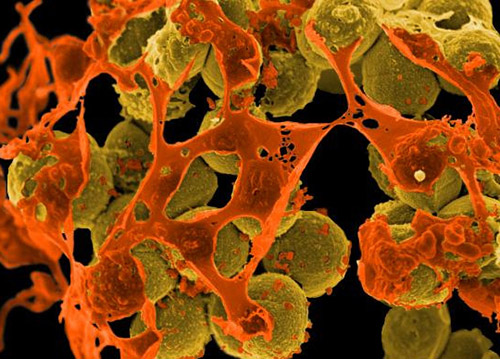
 AsianScientist (Mar. 5, 2012) – Infectious disease research in Asia and Australasia has just received a much needed boost – with the injection of a US$3.76 million research fund for diseases that affect the Asia-Pacific region.
AsianScientist (Mar. 5, 2012) – Infectious disease research in Asia and Australasia has just received a much needed boost – with the injection of a US$3.76 million research fund for diseases that affect the Asia-Pacific region.
The news was announced at the inaugural A*STAR-NHMRC joint symposium taking place from February 27-28 last week, jointly organized by Singapore’s Agency for Science, Technology and Research (A*STAR) and Australia’s National Health and Medical Research Council (NHMRC).
The symposium follows a Memorandum of Understanding (MOU) signed between A*STAR and NHMRC in September last year, and is likely to be followed by an AU$3.5 million (approximately US$3.76 million) joint grant call for infectious disease research.
There is a pressing need for better vaccines and treatments for infectious disease in Asia. Asia has historically been the epicenter for the emergence of new influenza viruses and experts are now predicting that the next pandemic will begin here. The 2009 H1N1 influenza A pandemic afflicted nearly 400,000 in Asia with 2,137 confirmed deaths.
Tuberculosis (TB) remains a major public health problem in the region, and accounts for 35 percent of cases globally, according to estimates by the World Health Organization (WHO). Emerging TB strains are showing resistance to available TB drugs, stressing the hospital systems that are unprepared to deal with them.
“Despite advances in science and medicine, infectious diseases continue to emerge at a rapid pace which can lead to significant social and economic impact. Global pandemic is a serious security threat that transcends borders and we need to adopt a transnational outlook and approach to be best prepared,” said A*STAR Chairman, Mr. Lim Chuan Poh, at the symposium.
During the symposium, we sat down for a chat with Professor Warwick Anderson, Chief Executive Officer (CEO) of Australia’s NHMRC, to learn more about Australia’s major governmental funding body for health and medical research.
Prof. Anderson, who was made a Member of the Order of Australia in 2005 for his contributions to medical research, was prior to his NHMRC appointment the Head of School of Biomedical Sciences at Monash University and Deputy Director of the Baker Medical Research Institute.
A renal biology and hypertension expert by training, Prof. Anderson shared with Asian Scientist Magazine more about NHMRC’s goals for 2012, the importance of having good science teachers, and finally, his personal love for research.
You are the keynote speaker at the A*STAR-NHMRC joint symposium this week. What is the goal of this symposium and could you tell us more about NHMRC’s collaboration with A*STAR?
About three months ago, we signed a Memorandum of Understanding (MOU) between Australia’s main medical research funding body, the NHMRC, and A*STAR.
What we plan to do is really develop stronger collaborative links between our two countries, and the symposium yesterday and today is to highlight and profile some of the great research in the two countries, with an idea of mixing the scientists and seeing if we can develop collaborations that way.
Shortly after, NHMRC and A*STAR will be issuing a joint call for applications in a particular aspect of infectious disease research.
Is there an indication of which infectious diseases A*STAR and NHMRC are going to support research on?
We haven’t decided yet. We are listening closely to the symposium and then A*STAR and NHMRC will discuss which areas we think we can target best to do some breakthrough research.
What would you say are the main priorities for NHMRC in the upcoming year?
We work on a three-year plan. And this year, 2012, is the last year of that plan.
The focus is really on funding quality research. Australia is a bigger country than Singapore, but still not very big compared to the United States and other countries. So we try to fund all research that is relevant to improving human health, from very basic to very applied, and right across the spectrum of disease.
But we have a particular focus on the health of Aboriginal Australians, who suffer much worse health outcomes than the rest of Australia.
We have also been focused on translational research, in other words, research that moves discovery on towards improving health; either from better evidence-based prevention, better operation of the health system, new treatments, or indeed, commercial outcomes of research.
What drives you as CEO of NHMRC, and are there any areas of research that you are personally committed to as its CEO?
Why I particularly enjoy this job so much is the opportunity to really support high quality research, and to make sure that the organization is always focused on high quality research, and its role in improving human health.
I do have a particular personal commitment to Aboriginal health and improving that, but I have also very much tried to help Australia research become highly connected to the world.
We’ve joined various international consortiums, such as the Global Alliance for Chronic Diseases (GACD), the International Cancer Genome Consortium (IGCC), and so on.
I am particular enthusiastic about Eastern Asia and the Pacific. I think that Singapore and Australia and the countries to our North have a particularly exciting future ahead of us, and so building collaborations and interactions is very exciting.
A new report issued by the Minster for Science and Research, Senator Chris Evans, showed that the total number of joint publications between Australia and China grew 20-fold in the period from 1996 to 2009.
Also, the University of Sydney, among other universities, has started to accept China’s GaoKao exam for admittance into an undergraduate program. Are increasing research and academic ties with China a trend for the future?
Well, there is no doubt that many Australian universities have strong links into China.
And on NHMRC grants, Chinese nationals can be co-chief investigators, as long the main investigator is an Australian at an Australian institution. The other investigators can come from anywhere. China is growing, but so are other countries as well.
Many Australian universities have a strong presence throughout China, so I do see this as a growth area in the future, but so are other countries of Southeast Asia, especially Singapore, where we have many strong relationships over many years.
A coalition that includes Australian professors called the Friends of Science in Medicine is advocating that complementary and alternative medicine (CAM) courses be removed as vocational degrees in universities across Australia. What is your opinion on this controversy?
I am aware that a number of people are concerned about this. Anything that we offer to patients should be as strongly evidence-based as possible.
In our current NHMRC three-year plan, one of the areas of particular effort is what we called “Investigating Alternative Therapy Claims.”
So, I suppose that the NHMRC view could be summarized in two ways: One, that any claim to improve human health should be investigated. That is what research is for, to investigate what improves human health and what doesn’t. So no process – whether surgery or anything else – should be exempt from being researched to see whether patients benefit from it.
The second thing that we are considering, the broader issue really, is the responsibility of health professionals to explain to patients the basis of the therapy they are offering. So for any form of therapy, and any form of health professionals from pharmacists to physiotherapists to doctors, we think that it is not unreasonable that the profession itself, and the individual health professionals, be honest and open with their patients on the evidence of the service they are offering.
We are not a higher-education body, that is the university sector, but we do think that there is a particular responsibility for all health professionals to be honest and clear about this.
A new Grattan Institute report has found that Western countries – including Australia – are slipping behind East Asian systems in school performance by two to three years, despite substantial increases in school funding.
Also, the number of Australians studying science in Years 11 and 12 has fallen from 94 percent in 1991 to 51 percent in 2010, according to a December 2011 report from the Australian Academy of Science. Do you have any comments on how this trend may be reversed?
I share the concern, and our chief scientist, Professor Ian Chubb, has also spoken very strongly about it, and I agree with his comments on it.
Every country, and Australia included, needs to keep its eye on the future. The future is increasingly a knowledge-based future, and science and math are essential to that future. It is not just so that we have great people doing medical research and engineering, but whole societies are increasingly based on science, from medicine to everything else. So I do share these concerns.
I got into science because I had a wonderful biology science teacher in high school, and I do think the support of teachers and science teachers is the most important single thing we can do, among other activities. Amongst all the competing influences, I think that teachers are the most important. When you talk to all scientists, they will identify a particular teacher who really just switched them on about science. I am not saying that is a magic bullet, but it is a really, really important thing.
I think this issue has at last got the country’s attention, and I very much hope that we can reverse that trend.
Before your appointment as CEO of NHMRC, you were a research professor at Monash University and the Baker Medical Research Institute. Could you share with us more about your scientific research and interests?
I’ve always been interested in cardiovascular disease, why so many people die too young including my own father, from cardiovascular disease.
I’m especially interested in high blood pressure (HBP), which is sort of a silent killer, because you don’t have any symptoms, but is devastating to health. And by some recognition, HBP is the second largest risk factor for health around the world, not only in rich countries, but also in poor countries. It seems so simple, one’s blood pressure is too high, but why is it? We are still trying finding out.
My belief is that it lies in the kidney, and that always seems quite illogical… what has the kidney got to do with HBP? But it has a lot to do with it. A lot of my research has focused on finding out the link between the kidney and HBP.
Towards the end of my time at Monash University, I also got very interested in the link between engineering and biomedical science. And I suppose, generally, I am an integrative sort of scientist, and I like to see the big picture. We need some of those, and then we also need some who can really narrow down on the molecular and cellular level.
I have had the best of possible worlds. I am now the head of an organization that sees all sorts of wonderful people doing wonderful research. I’ve moved from research to administration, and it is not a bad outcome to support other people doing wonderful research.
——
The NHMRC was established in 1936 to:
- Raise the standard of individual and public health throughout Australia.
- Foster medical research and training and public health research and training.
- Foster consideration of ethical issues relating to health.
——
Copyright: Asian Scientist Magazine; Photos: NHMRC.
Disclaimer: This article does not necessarily reflect the views of AsianScientist or its staff.













